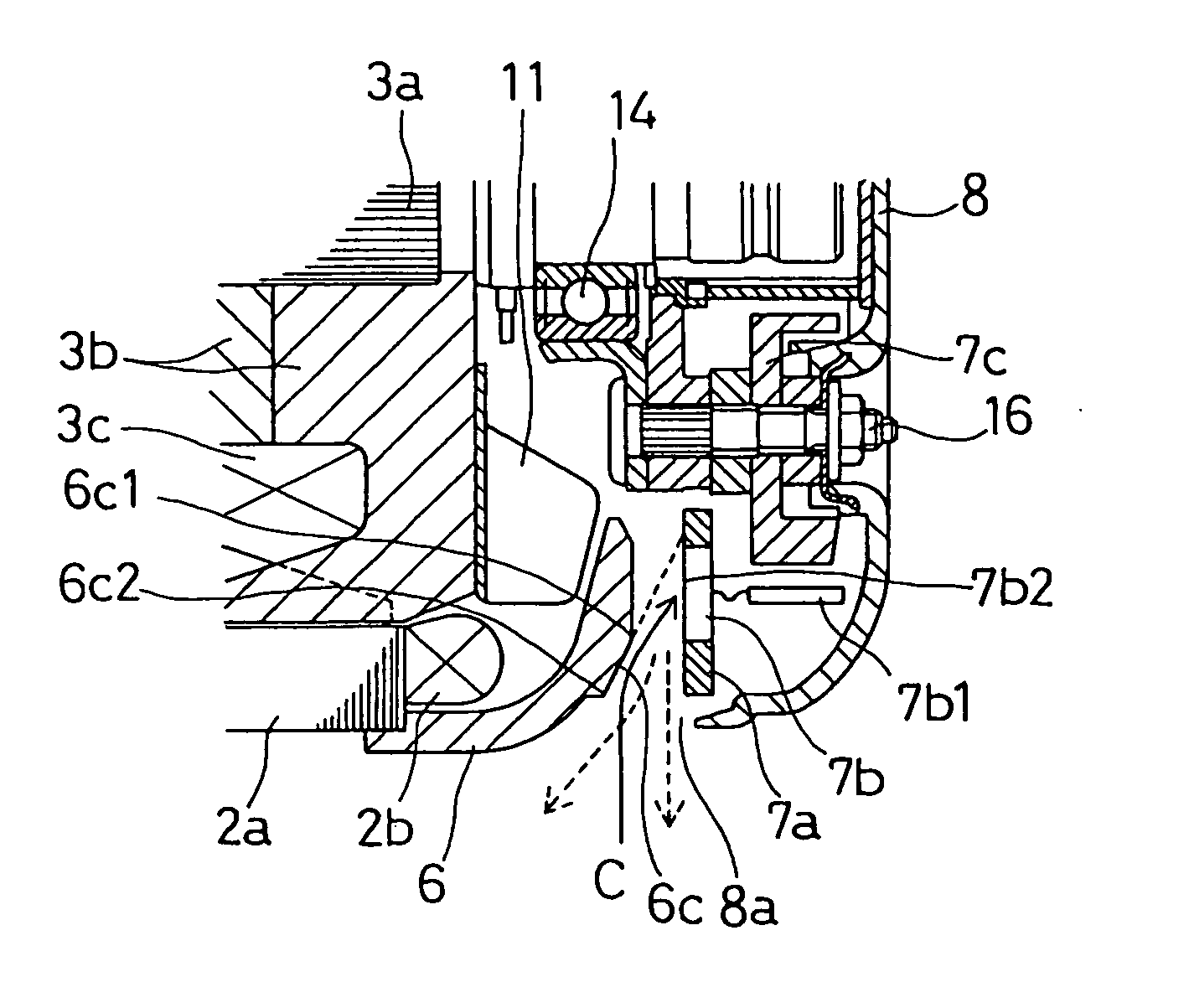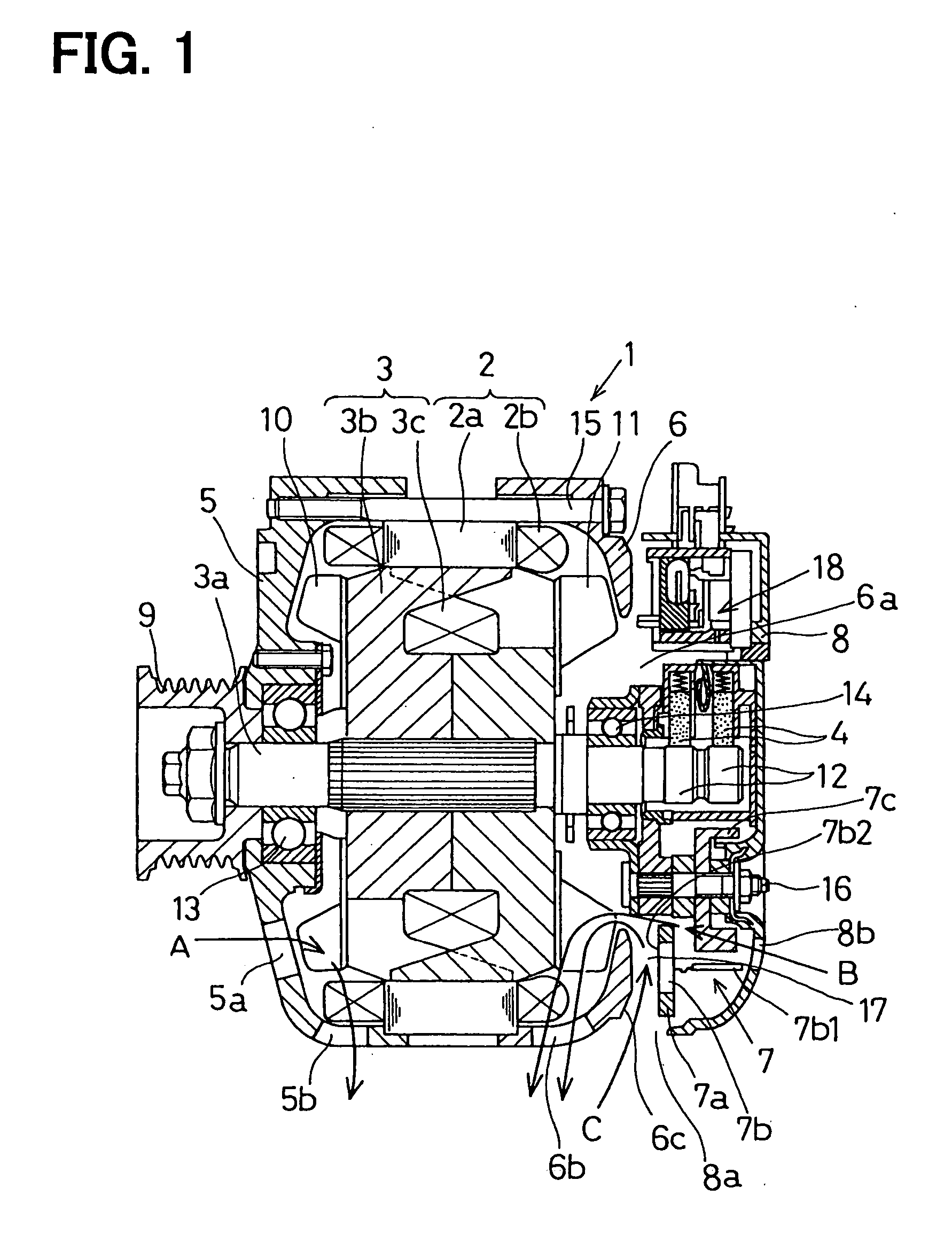AC generator for vehicle
- Summary
- Abstract
- Description
- Claims
- Application Information
AI Technical Summary
Benefits of technology
Problems solved by technology
Method used
Image
Examples
first embodiment
[0020] As shown in FIG. 1, an AC generator 1 for vehicle according to a first embodiment has a stator 2, a rotor 3, a brush 4, frames 5, 6, a rectifier 7 and a protection cover 8, which will be described below.
[0021] The stator 2 has a stator core 2a supported by the frames 5, 6, and an armature winding 2b winded on the stator 2. A rotation of the rotor 3 induces AC voltage in the armature winding 2b. For instance, the armature winding 2b has three armature coils, which are connected by a Y connection or by a delta connection.
[0022] The rotor 3 has a rotor shaft 3a to which a pulley 9 transmits a torque generated by an engine (not shown), a pair of pole cores (magnetic poles) 3b fixed onto the rotor shaft 3a and a field winding 3c wound on the pole cores 3b. The pulley 9 is fixed on one end portion of the rotor shaft 3a, and connected to a crank pulley (not shown) of the engine via a belt (not shown).
[0023] Cooling fans 10, 11 are respectively fixed to both axial end faces of the...
second embodiment
[0048] As shown in FIG. 3, an AC generator 1 according to a second embodiment is an example having a slant face 6c of which a start end 6c1 is radially inner side (upper side in FIG. 3) than the rectifier devices 7b.
[0049] According to this structure, a distance 17 between the slant face 6c and the rectifier devices 7b can be wide, so as not to stay muddy water and so on therein and to restrict corrosion of a holder fin 7a (especially at a portion where the rectifier devices 7b is press-fitted therein) by salt water and so on. Further, the slant face 6c induces the cooling wind to hit on a bottom faces 7b2 of the rectifier devices 7b effectively, so as to improve a performance in cooling the rectifier devices 7b.
third embodiment
[0050] As shown in FIG. 4, an AC generator 1 according to a third embodiment has heat radiation ribs 19 on the holder fin 7a at negative electric potential.
[0051] As shown in FIG. 5, a number of the heat radiation ribs 19 are disposed on a face of the holder fin 7a at a side of the rear frame 6, so as to be in a radial direction of the holder fin 7a along the flowing direction of the cooling wind.
[0052] According to this structure, the heat radiation ribs 19 on the holder fin 7a increase the area for heat radiation of the holder fin 7a, so as to improve a heat radiation performance thereof. Further, the heat radiation ribs 19 forms discharge passages therebetween for discharging muddy water that intruded thereinto, so as to improve a performance more in discharging the muddy water, etc.
[0053] Further, the slant face 6c on the rear frame 6 induces the cooling wind C to hit on the bottom faces 7b2 of the rectifier devices 7b and to cool the rectifier devices 7b effectively, as same...
PUM
 Login to View More
Login to View More Abstract
Description
Claims
Application Information
 Login to View More
Login to View More - R&D
- Intellectual Property
- Life Sciences
- Materials
- Tech Scout
- Unparalleled Data Quality
- Higher Quality Content
- 60% Fewer Hallucinations
Browse by: Latest US Patents, China's latest patents, Technical Efficacy Thesaurus, Application Domain, Technology Topic, Popular Technical Reports.
© 2025 PatSnap. All rights reserved.Legal|Privacy policy|Modern Slavery Act Transparency Statement|Sitemap|About US| Contact US: help@patsnap.com



